Comprehensive Assessment of Vulnerability to Storm Surges in Coastal China: Towards a Prefecture-Level Cities Perspective
Abstract
:1. Introduction
2. Study Area and Data Sources
2.1. Study Area
2.2. Data Sources
- (1)
- Land cover data
- (2)
- Digital elevation model (DEM) data
- (3)
- Coastline data
- (4)
- Point vector data of critical transportation facilities
- (5)
- Census data
- (6)
- Socio-economic data
3. Research Methods
3.1. Vulnerability Assessment Model
3.2. Selection and Processing of Indicators
3.3. Comprehensive Assessment Based on Weight Combination Strategy
3.3.1. Consistency Test
3.3.2. Combination Weighting Method
3.4. Spatial Analysis of Vulnerability
4. Results
4.1. Spatial Characteristics of Vulnerability Elements
4.1.1. Exposure
4.1.2. Sensitivity
4.1.3. Adaptability
4.2. Spatial Characteristics of Vulnerability
4.3. Global and Local Spatial Autocorrelation Analysis
5. Discussion
5.1. Comparison with Previous Studies
5.2. Implications for Policy Making
5.3. Uncertainties and Limitations
6. Conclusions
Supplementary Materials
Author Contributions
Funding
Data Availability Statement
Acknowledgments
Conflicts of Interest
References
- Hu, P.; Liu, Y.; Hou, Y. Studies on marine dynamic disasters. J. Oceanol. Limnol. 2019, 37, 1791–1794. [Google Scholar] [CrossRef]
- Fang, J.; Sun, S.; Shi, P.; Wang, J.A. Assessment and Mapping of Potential Storm Surge Impacts on Global Population and Economy. Int. J. Disaster Risk Sci. 2014, 5, 323–331. [Google Scholar] [CrossRef]
- Needham, H.F.; Keim, B.D.; Sathiaraj, D. A review of tropical cyclone-generated storm surges: Global data sources, observations, and impacts. Rev. Geophys. 2015, 53, 545–591. [Google Scholar] [CrossRef]
- Yi, X.; Sheng, K.; Wang, Y.; Wang, S. Can economic development alleviate storm surge disaster losses in coastal areas of China? Mar. Policy 2021, 129, 104531. [Google Scholar] [CrossRef]
- Shi, X.; Liu, S.; Yang, S.; Liu, Q.; Tan, J.; Guo, Z. Spatial–temporal distribution of storm surge damage in the coastal areas of China. Nat. Hazards 2015, 79, 237–247. [Google Scholar] [CrossRef]
- Wang, Y.; Liu, J.; Du, X.; Liu, Q.; Liu, X. Temporal-spatial characteristics of storm surges and rough seas in coastal areas of Mainland China from 2000 to 2019. Nat. Hazards 2021, 107, 1273–1285. [Google Scholar] [CrossRef]
- Ministry of Natural Resources of the People’s Republic of China. Bulletin of China Marine Disaster (1990–2020); Ministry of Natural Resources of the People’s Republic of China: Beijing, China, 2020.
- China National Commission for Disaster Reduction. 14th Five-Year Plan for National Comprehensive Disaster Prevention and Reduction; China National Commission for Disaster Reduction: Beijing, China, 2022. [Google Scholar]
- Fekete, A. Spatial disaster vulnerability and risk assessments: Challenges in their quality and acceptance. Nat. Hazards 2012, 61, 1161–1178. [Google Scholar] [CrossRef]
- Du, Y.; Ding, Y.; Li, Z.; Cao, G. The role of hazard vulnerability assessments in disaster preparedness and prevention in China. Mil. Med. Res. 2015, 2, 27. [Google Scholar] [CrossRef]
- de Chazal, J.; Quétier, F.; Lavorel, S.; Van Doorn, A. Including multiple differing stakeholder values into vulnerability assessments of socio-ecological systems. Glob. Environ. Chang. 2008, 18, 508–520. [Google Scholar] [CrossRef]
- Hufschmidt, G. A comparative analysis of several vulnerability concepts. Nat. Hazards 2011, 58, 621–643. [Google Scholar] [CrossRef]
- Huang, Y.; Li, F.; Bai, X.; Cui, S. Comparing vulnerability of coastal communities to land use change: Analytical framework and a case study in China. Environ. Sci. Policy 2012, 23, 133–143. [Google Scholar] [CrossRef]
- Bevacqua, A.; Yu, D.; Zhang, Y. Coastal vulnerability: Evolving concepts in understanding vulnerable people and places. Environ. Sci. Policy 2018, 82, 19–29. [Google Scholar] [CrossRef]
- Diaz-Sarachaga, J.M.; Jato-Espino, D. Analysis of vulnerability assessment frameworks and methodologies in urban areas. Nat. Hazards 2020, 100, 437–457. [Google Scholar] [CrossRef]
- IPCC. Climate Change 2001: Impacts, Adaptation, and Vulnerability Contribution of Working Group II to the Third Assessment Report of the Intergovernmental Panel on Climate Change; Cambridge University Press: Cambridge, UK, 2001. [Google Scholar]
- IPCC. Climate Change 2007: Impacts, Adaptation and Vulnerability: Contribution of Working Group II to the Fourth Assessment Report of the Intergovernmental Panel on Climate Change; Cambridge University Press: Cambridge, UK, 2007. [Google Scholar]
- Estoque, R.C.; Ishtiaque, A.; Parajuli, J.; Athukorala, D.; Rabby, Y.W.; Ooba, M. Has the IPCC’s revised vulnerability concept been well adopted? Ambio 2023, 52, 376–389. [Google Scholar] [CrossRef]
- Mahapatra, M.; Ratheesh, R.; Rajawat, A.S. Storm surge vulnerability assessment of Saurashtra coast, Gujarat, using GIS techniques. Nat. Hazards 2017, 86, 821–831. [Google Scholar] [CrossRef]
- Yu, H.; Shen, Y.; Kelly, R.M.; Qi, X.; Wu, K.; Li, S.; Yu, H.; Bao, X. Trends in social vulnerability to storm surges in Shenzhen, China. Nat. Hazards Earth Syst. Sci. 2020, 20, 2447–2462. [Google Scholar] [CrossRef]
- Liu, Y.; Lu, C.; Yang, X.; Wang, Z.; Liu, B. Fine-Scale Coastal Storm Surge Disaster Vulnerability and Risk Assessment Model: A Case Study of Laizhou Bay, China. Remote Sens. 2020, 12, 1301. [Google Scholar] [CrossRef]
- Zhu, J.; Lu, Y.; Ren, F.; McBride, J.L.; Ye, L. Typhoon disaster risk zoning for China’s coastal area. Front. Earth Sci. 2021, 16, 291–303. [Google Scholar] [CrossRef]
- Arun Kumar, A.; Kunte, P.D. Coastal vulnerability assessment for Chennai, east coast of India using geospatial techniques. Nat. Hazards 2012, 64, 853–872. [Google Scholar] [CrossRef]
- Zhang, Y.; Ruckelshaus, M.; Arkema, K.K.; Han, B.; Lu, F.; Zheng, H.; Ouyang, Z. Synthetic vulnerability assessment to inform climate-change adaptation along an urbanized coast of Shenzhen, China. J. Environ. Manag. 2020, 255, 109915. [Google Scholar] [CrossRef]
- Roukounis, C.N.; Tsihrintzis, V.A. Indices of Coastal Vulnerability to Climate Change: A Review. Environ. Process. 2022, 9, 29. [Google Scholar] [CrossRef]
- Ballesteros, C.; Esteves, L.S. Integrated Assessment of Coastal Exposure and Social Vulnerability to Coastal Hazards in East Africa. Estuaries Coasts 2021, 44, 2056–2072. [Google Scholar] [CrossRef] [PubMed]
- Sajjad, M.; Li, Y.; Tang, Z.; Cao, L.; Liu, X. Assessing Hazard Vulnerability, Habitat Conservation, and Restoration for the Enhancement of Mainland China’s Coastal Resilience. Earth’s Future 2018, 6, 326–338. [Google Scholar] [CrossRef]
- Gao, Y.; Wang, H.; Liu, G.M.; Sun, X.Y.; Fei, X.Y.; Wang, P.T.; Lv, T.T.; Xue, Z.S.; He, Y.W. Risk assessment of tropical storm surges for coastal regions of China. J. Geophys. Res. Atmos. 2014, 119, 5364–5374. [Google Scholar] [CrossRef]
- Liu, Q.; Ruan, C.; Zhong, S.; Li, J.; Yin, Z.; Lian, X. Risk assessment of storm surge disaster based on numerical models and remote sensing. Int. J. Appl. Earth Obs. Geoinf. 2018, 68, 20–30. [Google Scholar] [CrossRef]
- Xianwu, S.; Jufei, Q.; Bingrui, C.; Xiaojie, Z.; Haoshuang, G.; Jun, W.; Zhuyuan, B. Storm surge risk assessment method for a coastal county in China: Case study of Jinshan District, Shanghai. Stoch. Environ. Res. Risk Assess. 2020, 34, 627–640. [Google Scholar] [CrossRef]
- Wang, Y.; Guo, Z.; Zheng, S.; Zhang, M.; Shu, X.; Luo, J.; Qiu, L.; Gao, T. Risk assessment for typhoon-induced storm surges in Wenchang, Hainan Island of China. Geomat. Nat. Hazards Risk 2021, 12, 880–899. [Google Scholar] [CrossRef]
- Wang, S.; Mu, L.; Qin, H.; Wang, L.; Yao, Z.; Zhao, E. The utilization of physically based models and GIS techniques for comprehensive risk assessment of storm surge: A case study of Huizhou. Front. Mar. Sci. 2022, 9, 939380. [Google Scholar] [CrossRef]
- Paprotny, D.; Terefenko, P. New estimates of potential impacts of sea level rise and coastal floods in Poland. Nat. Hazards 2017, 85, 1249–1277. [Google Scholar] [CrossRef]
- Li, K.; Li, G.S. Vulnerability assessment of storm surges in the coastal area of Guangdong Province. Nat. Hazards Earth Syst. Sci. 2011, 11, 2003–2010. [Google Scholar] [CrossRef]
- Zhang, Y.; Guo, J.; Che, Z. Discussion on evaluating the vulnerability of storm surge hazard bearing bodies in the coastal areas of Wenzhou. Front. Earth Sci. 2015, 9, 300–307. [Google Scholar] [CrossRef]
- Yan, B.; Li, S.; Wang, J.; Ge, Z.; Zhang, L. Socio-economic vulnerability of the megacity of Shanghai (China) to sea-level rise and associated storm surges. Reg. Environ. Chang. 2016, 16, 1443–1456. [Google Scholar] [CrossRef]
- Liu, J.; Gong, J.-H.; Liang, J.-M.; Li, Y.; Kang, L.-C.; Song, L.-L.; Shi, S.-X. A quantitative method for storm surge vulnerability assessment—a case study of Weihai city. Int. J. Digit. Earth 2017, 10, 539–559. [Google Scholar] [CrossRef]
- Huang, X.; Jin, H.; Bai, H. Vulnerability assessment of China’s coastal cities based on DEA cross-efficiency model. Int. J. Disaster Risk Reduct. 2019, 36, 101091. [Google Scholar] [CrossRef]
- Yuan, S.; Guo, J.; Zhao, X. Integrated Weighting Technique for Coastal Vulnerability to Storm Surges. J. Coast. Res. 2017, 80, 6–12, 17. [Google Scholar] [CrossRef]
- Sajjad, M.; Chan, J.C.L. Risk assessment for the sustainability of coastal communities: A preliminary study. Sci. Total Environ. 2019, 671, 339–350. [Google Scholar] [CrossRef]
- Sajjad, M.; Chan, J.C.L.; Kanwal, S. Integrating spatial statistics tools for coastal risk management: A case-study of typhoon risk in mainland China. Ocean Coast. Manag. 2020, 184, 105018. [Google Scholar] [CrossRef]
- Wang, G.; Liu, Y.; Wang, H.; Wang, X. A comprehensive risk analysis of coastal zones in China. Estuar. Coast. Shelf Sci. 2014, 140, 22–31. [Google Scholar] [CrossRef]
- Su, S.; Pi, J.; Wan, C.; Li, H.; Xiao, R.; Li, B. Categorizing social vulnerability patterns in Chinese coastal cities. Ocean Coast. Manag. 2015, 116, 1–8. [Google Scholar] [CrossRef]
- Wang, W.; Liu, H.; Li, Y.; Su, J. Development and management of land reclamation in China. Ocean Coast. Manag. 2014, 102, 415–425. [Google Scholar] [CrossRef]
- National Bureau of Statistics of the People’s Republic of China. Available online: http://www.stats.gov.cn/sj/ndsj/2021/indexch.htm (accessed on 1 January 2023).
- Newton, A.; Weichselgartner, J. Hotspots of coastal vulnerability: A DPSIR analysis to find societal pathways and responses. Estuar. Coast. Shelf Sci. 2014, 140, 123–133. [Google Scholar] [CrossRef]
- Earth Engine Data Catalog. Available online: https://developers.google.com/earth-engine/datasets (accessed on 1 January 2023).
- Gao, Y.; Wang, H.; Su, F.; Liu, G. The analysis of spatial and temporal changes of the continental coastlines of China in recent three decades. Acta Oceanol. Sin. 2013, 35, 31–42. [Google Scholar]
- Yan, F.; Wang, X.; Su, F. Ecosystem service changes in response to mainland coastline movements in China: Process, pattern, and trade-off. Ecol. Indic. 2020, 116, 106337. [Google Scholar] [CrossRef]
- The National Catalogue Service for Geographic Information. Available online: https://www.webmap.cn/commres.do?method=dataDownload (accessed on 1 July 2023).
- The State Council of the People’s Republic of China. Available online: https://www.gov.cn/guoqing/2021-05/13/content_5606149.htm (accessed on 1 January 2023).
- Regional Development Statistics Database. Available online: http://cnki.nbsti.net/CSYDMirror/area/Yearbook/Single/N2022040095?z=D26 (accessed on 1 January 2023).
- Bukvic, A.; Rohat, G.; Apotsos, A.; de Sherbinin, A. A Systematic Review of Coastal Vulnerability Mapping. Sustainability 2020, 12, 2822. [Google Scholar] [CrossRef]
- Nguyen, T.T.X.; Bonetti, J.; Rogers, K.; Woodroffe, C.D. Indicator-based assessment of climate-change impacts on coasts: A review of concepts, methodological approaches and vulnerability indices. Ocean Coast. Manag. 2016, 123, 18–43. [Google Scholar] [CrossRef]
- Lima, C.O.; Bonetti, J. Bibliometric analysis of the scientific production on coastal communities’ social vulnerability to climate change and to the impact of extreme events. Nat. Hazards 2020, 102, 1589–1610. [Google Scholar] [CrossRef]
- Adger, W.N. Vulnerability. Glob. Environ. Chang. 2006, 16, 268–281. [Google Scholar] [CrossRef]
- Ge, Y.; Dou, W.; Liu, N. Planning Resilient and Sustainable Cities: Identifying and Targeting Social Vulnerability to Climate Change. Sustainability 2017, 9, 1394. [Google Scholar] [CrossRef]
- Füssel, H.-M.; Klein, R.J.T. Climate Change Vulnerability Assessments: An Evolution of Conceptual Thinking. Clim. Change 2006, 75, 301–329. [Google Scholar] [CrossRef]
- Meng, D.; Liu, Y.; Wang, Z.; Yang, X.; Liu, X.; Zhang, J.; Gao, K. Decreasing Vulnerability of Storm Surge Disasters in Coastal Cities of China over the Past 30 Years. J. Mar. Sci. Eng. 2023, 11, 128. [Google Scholar] [CrossRef]
- Frigerio, I.; De Amicis, M. Mapping social vulnerability to natural hazards in Italy: A suitable tool for risk mitigation strategies. Environ. Sci. Policy 2016, 63, 187–196. [Google Scholar] [CrossRef]
- Cutter, S.L.; Boruff, B.J.; Shirley, W.L. Social Vulnerability to Environmental Hazards. Soc. Sci. Q. 2003, 84, 242–261. [Google Scholar] [CrossRef]
- Zhou, Y.; Li, N.; Wu, W.; Wu, J.; Shi, P. Local Spatial and Temporal Factors Influencing Population and Societal Vulnerability to Natural Disasters. Risk Anal. 2014, 34, 614–639. [Google Scholar] [CrossRef] [PubMed]
- Liu, X.; Wang, Z.; Yang, X.; Liu, Y.; Liu, B.; Zhang, J.; Gao, K.; Meng, D.; Ding, Y. Mapping China’s offshore mariculture based on dense time-series optical and radar data. Int. J. Digit. Earth 2022, 15, 1326–1349. [Google Scholar] [CrossRef]
- Wang, Z.; Zhang, J.; Yang, X.; Huang, C.; Su, F.; Liu, X.; Liu, Y.; Zhang, Y. Global mapping of the landside clustering of aquaculture ponds from dense time-series 10 m Sentinel-2 images on Google Earth Engine. Int. J. Appl. Earth Obs. Geoinf. 2022, 115, 103100. [Google Scholar] [CrossRef]
- Chen, Q.; Shen, W.; Yu, B. Assessing the Vulnerability of Marine Fisheries in China: Towards an Inter-Provincial Perspective. Sustainability 2018, 10, 4302. [Google Scholar] [CrossRef]
- Do, C.; Kuleshov, Y. Tropical cyclone multi-hazard risk mapping for Queensland, Australia. Nat. Hazards 2023, 116, 3725–3746. [Google Scholar] [CrossRef]
- Smit, B.; Wandel, J. Adaptation, adaptive capacity and vulnerability. Glob. Environ. Chang. 2006, 16, 282–292. [Google Scholar] [CrossRef]
- Li, Q.; Shi, X.; Wu, Q. Effects of protection and restoration on reducing ecological vulnerability. Sci. Total Environ. 2021, 761, 143180. [Google Scholar] [CrossRef]
- Zhao, S.A.; Chai, L.H. A new assessment approach for urban ecosystem health basing on maximum information entropy method. Stoch. Environ. Res. Risk Assess. 2015, 29, 1601–1613. [Google Scholar] [CrossRef]
- Chen, P. On the Diversity-Based Weighting Method for Risk Assessment and Decision-Making about Natural Hazards. Entropy 2019, 21, 269. [Google Scholar] [CrossRef]
- Kuo, T. A modified TOPSIS with a different ranking index. Eur. J. Oper. Res. 2017, 260, 152–160. [Google Scholar] [CrossRef]
- Yang, Y.; Song, G. Human disturbance changes based on spatiotemporal heterogeneity of regional ecological vulnerability: A case study of Qiqihaer city, northwestern Songnen Plain, China. J. Clean Prod. 2021, 291, 125262. [Google Scholar] [CrossRef]
- Hu, X.; Ma, C.; Huang, P.; Guo, X. Ecological vulnerability assessment based on AHP-PSR method and analysis of its single parameter sensitivity and spatial autocorrelation for ecological protection–A case of Weifang City, China. Ecol. Indic. 2021, 125, 107464. [Google Scholar] [CrossRef]
- Fang, J.; Liu, W.; Yang, S.; Brown, S.; Nicholls, R.J.; Hinkel, J.; Shi, X.; Shi, P. Spatial-temporal changes of coastal and marine disasters risks and impacts in Mainland China. Ocean Coast. Manag. 2017, 139, 125–140. [Google Scholar] [CrossRef]
- Yin, J.; Yin, Z.; Xu, S. Composite risk assessment of typhoon-induced disaster for China’s coastal area. Nat. Hazards 2013, 69, 1423–1434. [Google Scholar] [CrossRef]
- Xu, X.; Sun, D.; Guo, T. A systemic analysis of typhoon risk across China. Nat. Hazards 2015, 77, 461–477. [Google Scholar] [CrossRef]
- Kang, J.; Yang, X.; Wang, Z.; Cheng, H.; Wang, J.; Tang, H.; Li, Y.; Bian, Z.; Bai, Z. Comparison of Three Ten Meter Land Cover Products in a Drought Region: A Case Study in Northwestern China. Land 2022, 11, 427. [Google Scholar] [CrossRef]
- Wang, J.; Yang, X.; Wang, Z.; Cheng, H.; Kang, J.; Tang, H.; Li, Y.; Bian, Z.; Bai, Z. Consistency Analysis and Accuracy Assessment of Three Global Ten-Meter Land Cover Products in Rocky Desertification Region—A Case Study of Southwest China. ISPRS Int. J. Geo-Inf. 2022, 11, 202. [Google Scholar] [CrossRef]
- Zhao, T.; Zhang, X.; Gao, Y.; Mi, J.; Liu, W.; Wang, J.; Jiang, M.; Liu, L. Assessing the Accuracy and Consistency of Six Fine-Resolution Global Land Cover Products Using a Novel Stratified Random Sampling Validation Dataset. Remote Sens. 2023, 15, 2285. [Google Scholar] [CrossRef]
- The State Council of the People’s Republic of China. National Seawall Construction Program; The State Council of the People’s Republic of China: Beijing, China, 2017.
- Ke, Q. Flood Risk Analysis for Metropolitan Areas—A Case Study for Shanghai. Ph.D. Thesis, Delft University of Technology, Delft, The Netherlands, 2014. [Google Scholar]
- Xu, H.; Tian, Z.; Sun, L.; Ye, Q.; Ragno, E.; Bricker, J.; Mao, G.; Tan, J.; Wang, J.; Ke, Q.; et al. Compound flood impact of water level and rainfall during tropical cyclone periods in a coastal city: The case of Shanghai. Nat. Hazards Earth Syst. Sci. 2022, 22, 2347–2358. [Google Scholar] [CrossRef]
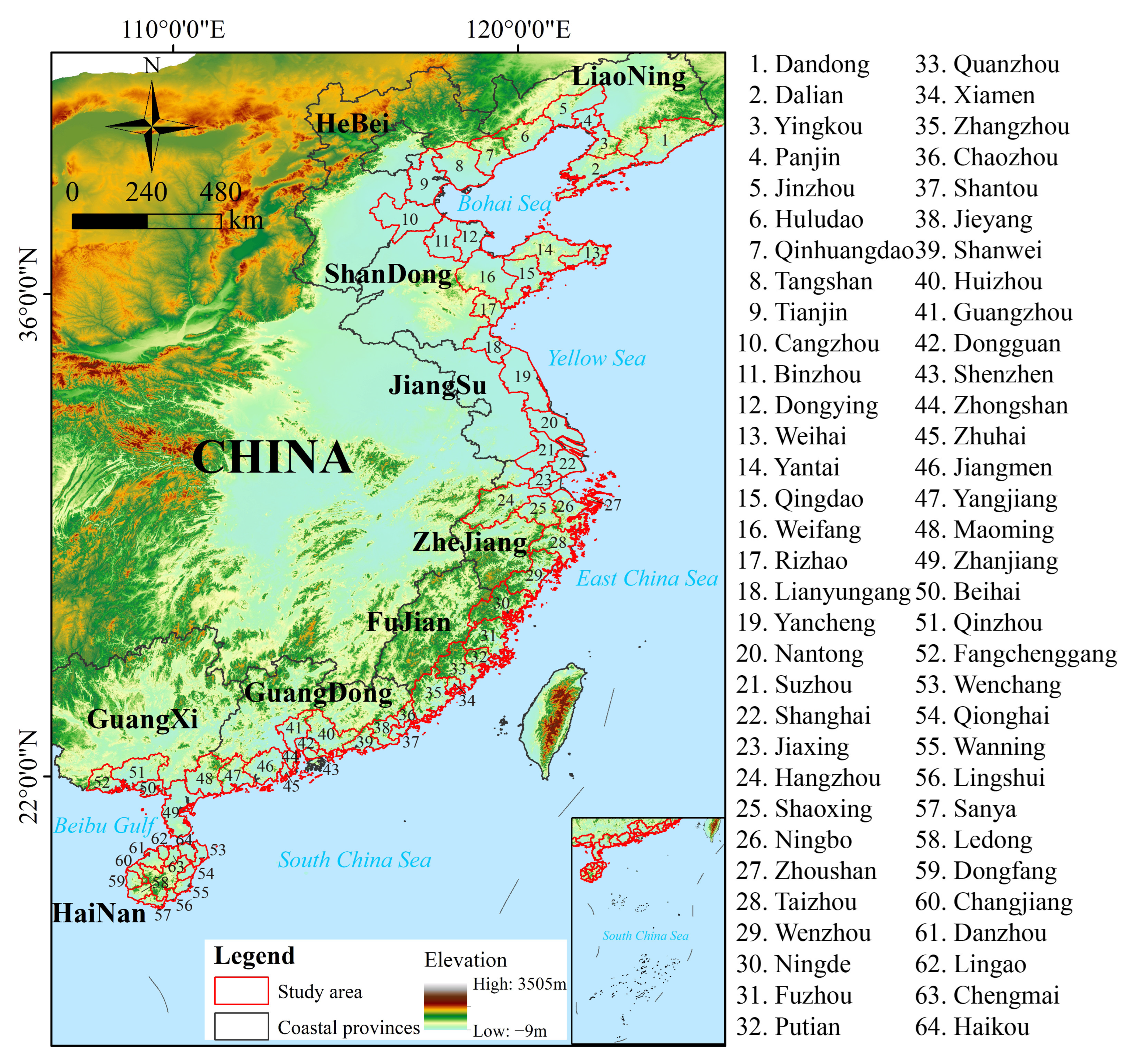
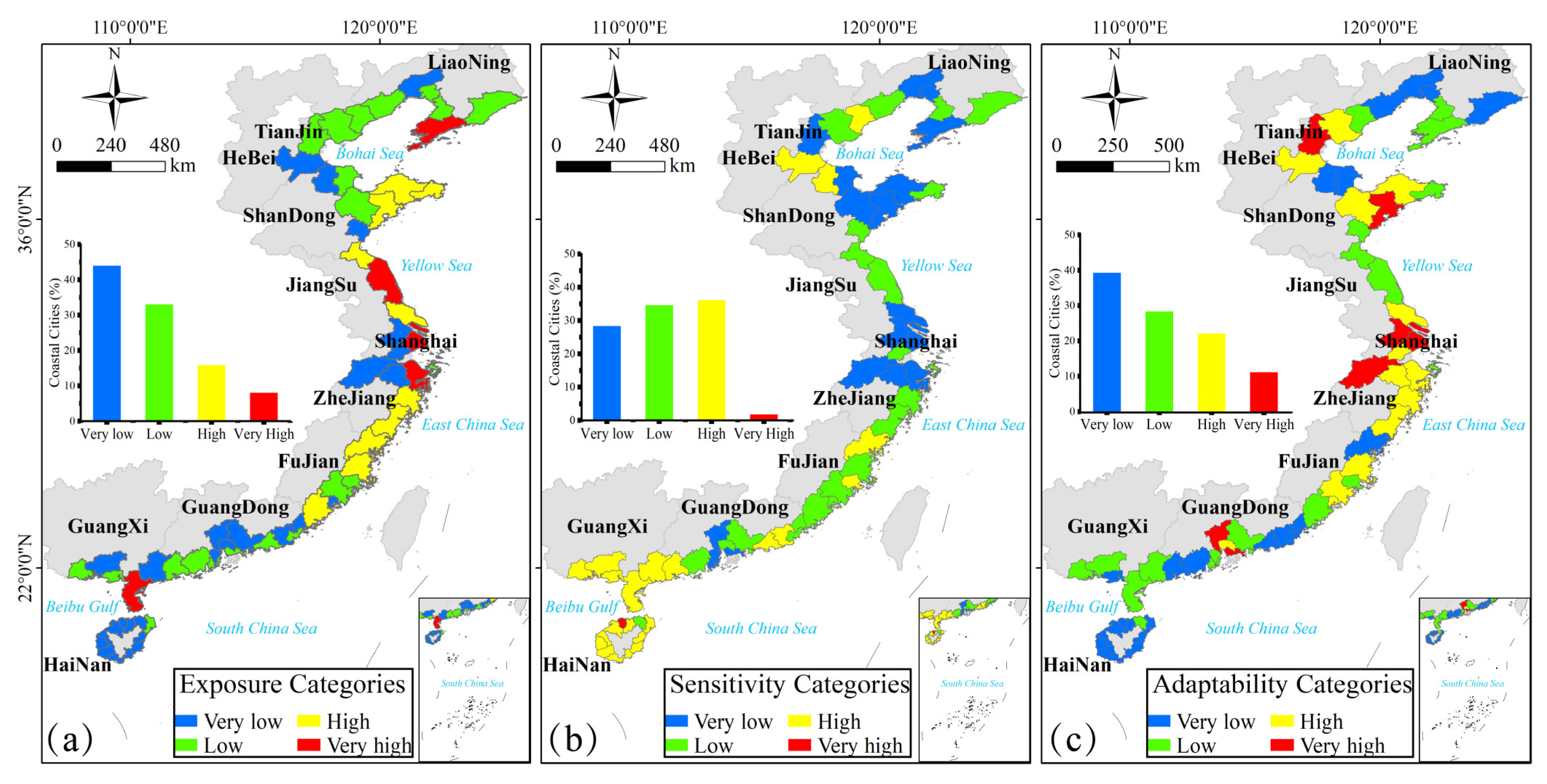
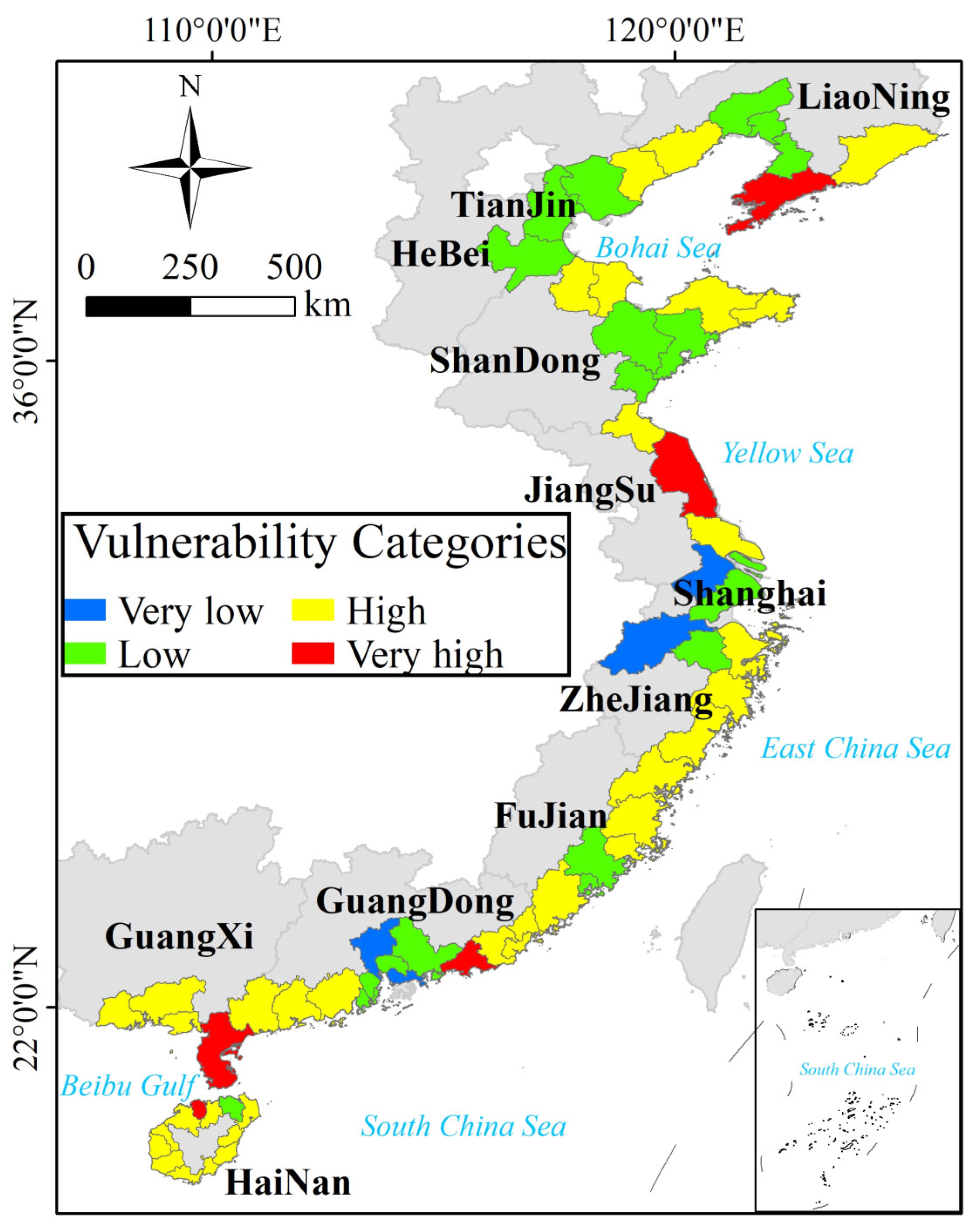
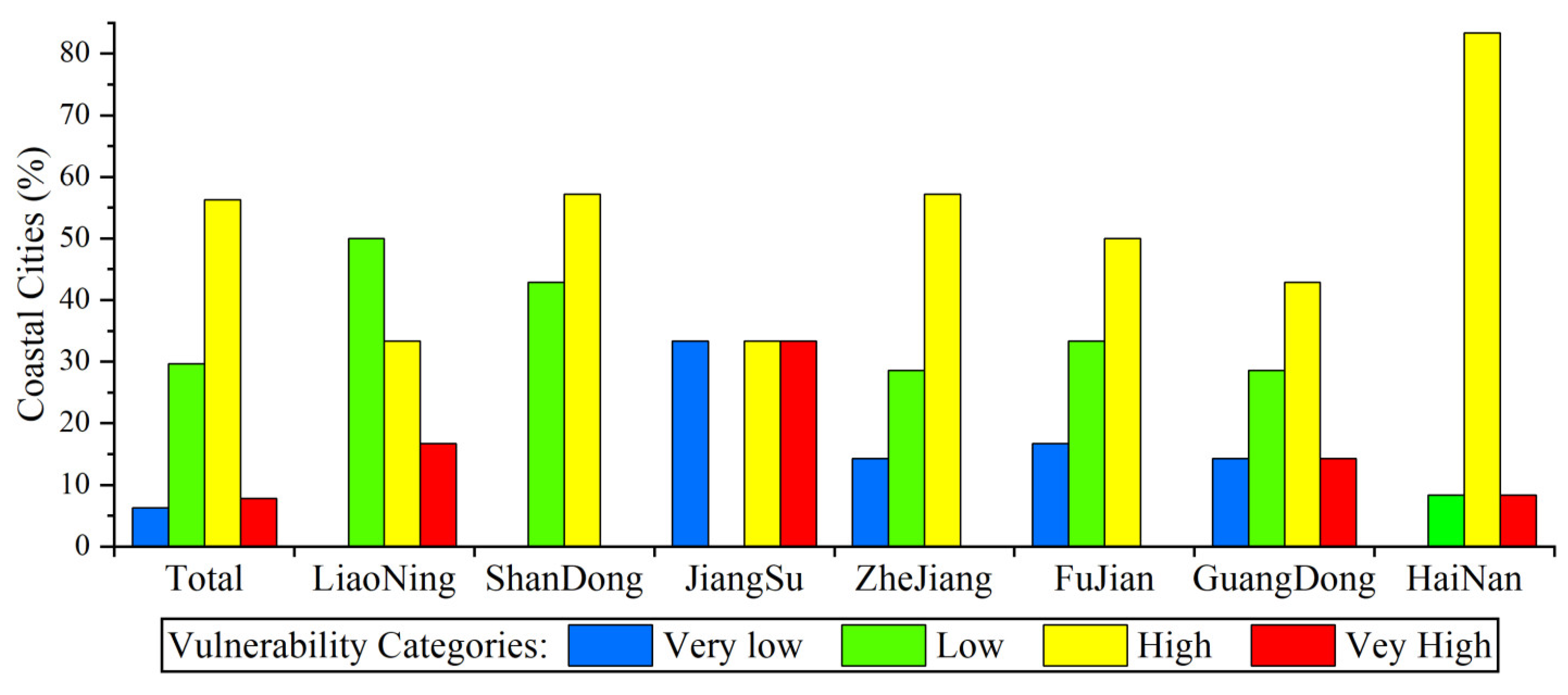
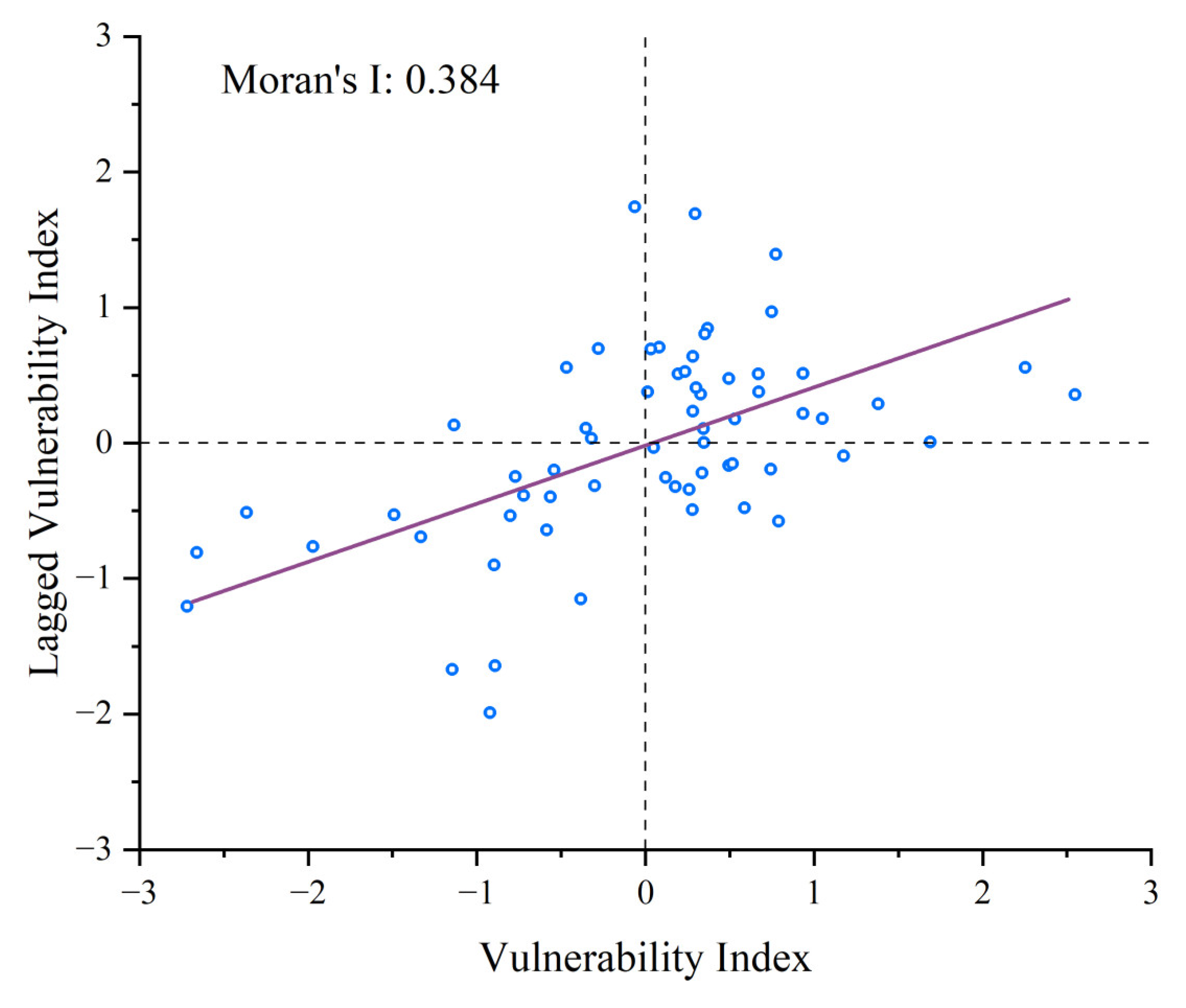
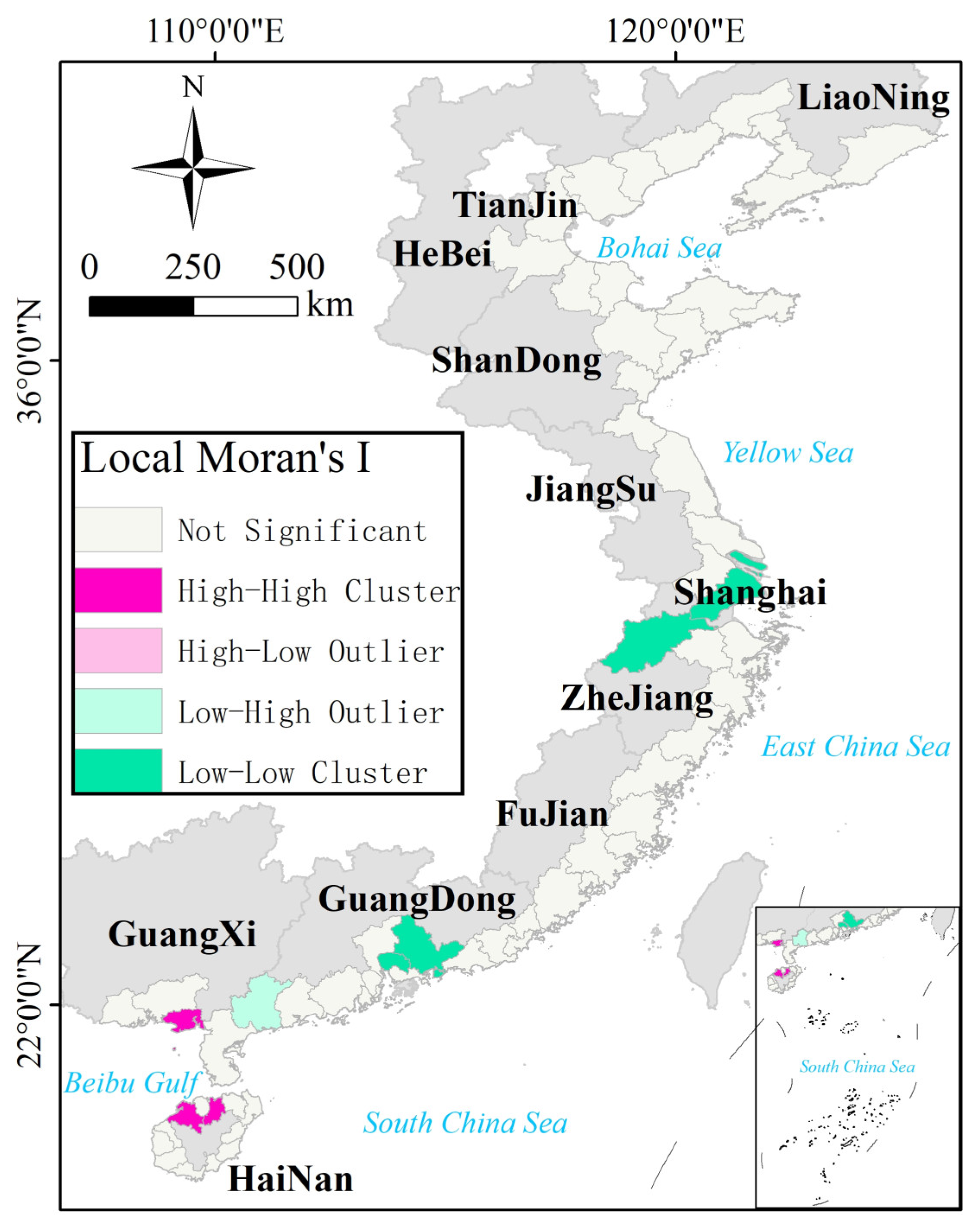
| Factor | Judgment Criterion | Exposure Value | Expert Score | Weight |
|---|---|---|---|---|
| Land cover | Impervious surface | 1 | 9 | 0.5 |
| Cropland | 0.8 | |||
| Wetland | 0.6 | |||
| Vegetation | 0.4 | |||
| Other | 0.2 | |||
| Elevation (m) | <1.0 | 1 | 3 | 0.167 |
| 1.0–3.0 | 0.8 | |||
| 3.0–5.0 | 0.6 | |||
| 5.0–10.0 | 0.4 | |||
| >10.0 | 0.2 | |||
| Slope | <0.5° | 1 | 2 | 0.111 |
| 0.5°–2.0° | 0.8 | |||
| 2.0°–5.0° | 0.6 | |||
| 5.0°–15.0° | 0.4 | |||
| >15.0° | 0.2 | |||
| Distance to water (km) | <0.5 | 1 | 4 | 0.222 |
| 0.5–1.0 | 0.8 | |||
| 1.0–2.0 | 0.6 | |||
| 2.0–5.0 | 0.4 | |||
| >5.0 | 0.2 |
| Vulnerability Dimension | No. | Indicator | Impact to Vulnerability |
|---|---|---|---|
| Exposure | 1 | Total area of land cover with exposure values of 0.2–0.4 (km2) | + |
| 2 | Total area of land cover with exposure values of 0.5–0.7 (km2) | + | |
| 3 | Total area of land cover with exposure values of 0.8–1.0 (km2) | + | |
| 4 | Density of critical transportation facilities (facilities/km2) | + | |
| Sensitivity | 5 | Percentage of population aged 14 and under (%) | + |
| 6 | Percentage of population aged 65 and above (%) | + | |
| 7 | Percentage of population with junior high school education or below (%) | + | |
| 8 | Ratio of fishery output to GDP (%) | + | |
| Adaptability | 9 | General public budget expenditure (CNY 100 million) | − |
| 10 | GDP (CNY 100 million) | − | |
| 11 | Urban disposable income per capita (CNY) | − | |
| 12 | Rural disposable income per capita (CNY) | − | |
| 13 | Number of hospital medical staff | − | |
| 14 | Number of medical institutions | − | |
| 15 | Proportion of artificial and biogenic coastlines (%) | − |
| Vulnerability Components | Kendall’s W | X2 | p |
|---|---|---|---|
| Exposure | 0.985 | 248.187 | 0.000 *** |
| Sensitivity | 0.942 | 237.391 | 0.000 *** |
| Adaptability | 0.984 | 247.947 | 0.000 *** |
Disclaimer/Publisher’s Note: The statements, opinions and data contained in all publications are solely those of the individual author(s) and contributor(s) and not of MDPI and/or the editor(s). MDPI and/or the editor(s) disclaim responsibility for any injury to people or property resulting from any ideas, methods, instructions or products referred to in the content. |
© 2023 by the authors. Licensee MDPI, Basel, Switzerland. This article is an open access article distributed under the terms and conditions of the Creative Commons Attribution (CC BY) license (https://creativecommons.org/licenses/by/4.0/).
Share and Cite
Liu, X.; Liu, Y.; Wang, Z.; Yang, X.; Zeng, X.; Meng, D. Comprehensive Assessment of Vulnerability to Storm Surges in Coastal China: Towards a Prefecture-Level Cities Perspective. Remote Sens. 2023, 15, 4828. https://doi.org/10.3390/rs15194828
Liu X, Liu Y, Wang Z, Yang X, Zeng X, Meng D. Comprehensive Assessment of Vulnerability to Storm Surges in Coastal China: Towards a Prefecture-Level Cities Perspective. Remote Sensing. 2023; 15(19):4828. https://doi.org/10.3390/rs15194828
Chicago/Turabian StyleLiu, Xiaoliang, Yueming Liu, Zhihua Wang, Xiaomei Yang, Xiaowei Zeng, and Dan Meng. 2023. "Comprehensive Assessment of Vulnerability to Storm Surges in Coastal China: Towards a Prefecture-Level Cities Perspective" Remote Sensing 15, no. 19: 4828. https://doi.org/10.3390/rs15194828
APA StyleLiu, X., Liu, Y., Wang, Z., Yang, X., Zeng, X., & Meng, D. (2023). Comprehensive Assessment of Vulnerability to Storm Surges in Coastal China: Towards a Prefecture-Level Cities Perspective. Remote Sensing, 15(19), 4828. https://doi.org/10.3390/rs15194828








